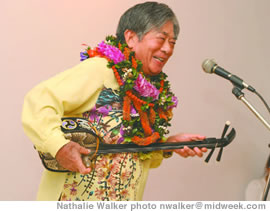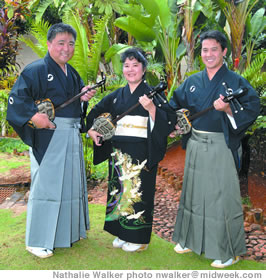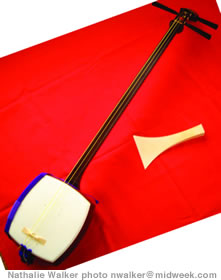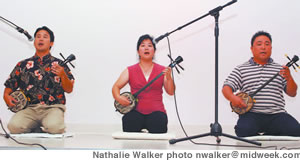SHAMISEN
The people of Hawaii have accomplished some pretty cool stuff over the years. Duke Kahanamoku brought home Olympic gold, Ellison Onizuka made it into space, and Mr. Checkers convinced us that riding

By .(JavaScript must be enabled to view this email address)
E-mail this story | Print this page | Archive | RSS

|
The people of Hawaii have accomplished some pretty cool stuff over the years. Duke Kahanamoku brought home Olympic gold, Ellison Onizuka made it into space, and Mr. Checkers convinced us that riding around in a car painted like a tablecloth can be cool. But until recently no one had done what three Oahu musicians have done. In fact, they are the only ones outside of Japan to accomplish the feat.
Kenton Odo, June Nakama and Calvin Nakama became the first foreigners to earn a master’s certificate in the Okinawan shamisen - an accomplishment so important that they needed the teaching of a national living treasure and had their ability certified by the prefecture of Okinawa.
“We didn’t know until we passed,” says Odo, an architect for MC Architects. “We thought people went before us.”
As it turns out, it was a good thing the historic accomplishment remained a mystery. After 15 years of study, the stress level tends to max out as the students must sit before longtime masters while playing perfectly within a precise structure. Being on your knees for 20 minutes isn’t the easiest thing either.
“Taking the test alone is pressure. If they would have told us (we would be the first) it would have been much worse,” says Calvin Nakama, who had the added responsibility of being the first one tested - a scary position that may have turned into a blessing.
“I was the first one to play. I was kind of nervous, but I had an advantage because I didn’t have to listen to anyone else sing,” says the 44-year-old Kaimuki High School grad who works for the City and County of Honolulu. “With the different keys and all the different voices, some can get confused as they are waiting in the back, and they get thrown off.” It must have been a good day for everyone. In addition to the three Hawaii imports making history, each of the 22 students from their teacher’s class also passed. Yet another first.
While thought to be a traditional Japanese instrument, the shamisen came to Okinawa by way of China some 500 years ago. The Chinese sanxian - a precursor to the shamisen - evolved from similar instruments common throughout Central Asia.

|
On the surface, the shamisen seems like an easy instrument to play. It’s relatively small, has only three strings and is tuned to the key of the singer’s voice. So just pluck and go. And while Odo sticks to his story about it being easy “because we want people to come in and take a lesson so we can spread our culture,” the fact is that, like most endeavors, getting good at something takes effort.
June’s answer may be closer to the truth.
“If we take what Terukina sensei tells us, it’s 30 percent talent and 70 percent desire. He said the talent itself is just a small part of if, but that anyone who wants to do it can do it,” she says.
The sensei she refers to is Choichi Terukina, an Okinawan musician who was named a national living treasure by the Japanese government and who, to his students, is a combination of mentor and spiritual guide.
The 75-year-old is the driving force behind a Nov. 27 concert at the Hawaii Theatre, which will feature traditional, modern and classic Okinawan music along with a few surprises that he has written especially for the day.
“Even in his 70s, he’s still trying to make things different so every time he sings, it will be a little better and a little better,” says an admiring Odo.

“It’s going to have traditional, modern and some unique things that people will be bringing from Okinawa that most Hawaii people would not get a chance to see,” adds June. “We’re going to be treated to a lot of variety that night.”
Moving up the ranks of the Okinawan shamisen is a three-step process. For each, the student must learn a series of songs and then fly to Okinawa to be tested. Once they pass, they must wait three years before taking the next test and, much like the bar exam, there is no penalty for failure. You can take the test as often as needed.
While the three’s interest in the instrument evolved along different lines, they all found their way to the same point for the same reason: Each discovered a need to learn more about their culture. Not an unheard of idea for someone growing up thousands of miles from their ancestral home, but seemingly a bit off for someone born closer to the source.
Calvin was born in Okinawa and moved with his family to Hawaii at the age of 13. At the time, his interests were focused on becoming more American and being like his Hawaii-born friends and classmates. He had no interest in Okinawa. This changed when he returned home and discovered what he had been missing.
“It was not until I went back to Okinawa that I got interested in the culture,” he says. “I went to an Okinawan festival and I thought it was very interesting.”
One of the difficulties in obtaining the rare accreditation is that the student is forced to go back in time. The journey begins with modern songs and as the musicians rise in rank, the tunes get older and older. Not only must they master songs that are 300 years old, but they are a far sight different from what they are used to. Classic Okinawan shamisen is not likely to hit the Billboard Hot 100.

|
Played in the modern style, shamisen music can be compared to bluegrass banjo with its quick-picking, uptempo style. But to be one of the best, it is not enough to play as fast as you can. A good Okinawan shamisen player must also learn to slow things down and to play in a style that many think is, well, boring.
“I was the one who would fall asleep,” says June of her early introduction to the classic style of the music. “But now that we’ve done our second-level tests and our third-level tests, you get the root of it and you hear the poems and they tell you the story about what the song really means.”
Though it may have taken time for them to appreciate the nuances of the older styles, each is now committed to continuing its legacy and to expose as many people as possible to their culture through music.
“This is something that we do need to continue before it is lost,” says June, a social worker for the state Department of Health. “I think there are a lot of people trying to get back to their roots, and I want to be part of that.”
It’s an idea supported by Maryknoll grad Odo.
“What I want to do is I want classical music to grow here. Everybody here plays folk music. They think that nobody wants to hear the classics. I just think it’s not placed in the right context. If you don’t understand the meaning it’s going to be confusing, but if you know what it’s about and what they are trying to do, you’re understanding all this history. It’s like opera. People pay big bucks to hear opera and they have no idea what they are saying. Why not Okinawan classical music?”
So now that they have achieved such lofty status, does that mean the learning is over? Even though they have passed the highest exam and already have their teaching credentials, the lessons are far from over. To those serious about mastering the ancient instrument, passing the master’s test is only the beginning.
“It’s not playing so much, it’s how you can pull out the meaning of the song. Sensei said you’re not going to be the best until the day you die because of your life experiences. Like when I was 19 playing shamisen, I thought I was pretty good playing a happy song or even a sad song. What was happy to me then, ‘oh I got an A on my test’ or what’s sad, ‘oh I broke up with my girlfriend.‘Now I’m 37 years old and my grandfather passed on; I saw him die. Or happy is like I got married, I saw my child being born. It’s totally different.”
Now that they have been recognized for their playing, the three want nothing more than to share their knowledge with others, even though Calvin says their understanding of their culture has just begun. So, if they are not yet ready after 15 years of study, when will they be? Odo has an answer which, of course, goes back to their teacher.
“I’m as happy as the flower blooming in the morning dew. When you can sing like that flower, then you’ve got it.” says Odo, recalling the master’s answer that only confused him even more. “I’m like, how the hell, that’s too deep! These are 300-year-old songs, and I’m thinking this culture is something else. It just blew my mind!”
Talk about pressure.
On Nov. 22, Odo and June Nakama will accomplish another first. Since they had placed first and third respectively among those who passed the historic test, they have been invited back to Okinawa to perform. The invitation came from the living legend, Terukina sensei.
For more information on the Nov. 27 concert, call the Hawaii Theatre at 528-0506.
Page 1 of 1 pages for this story
E-mail this story | Print this page | Comments (0) | Archive | RSS
Most Recent Comment(s):








